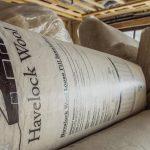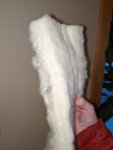I just started adding Havlock to my OVRLND camper. You don't really "stuff" Havlock wool for the most part, it comes in these 2" thick batts that are not loose wool, kind of "blended", and are just laid into an area. See attached photo of a cut batt. You would only stuff it for really small spaces. You would have to really pack it in to the point of ridiculousness to really loose R-value and that would be in places that other insulations wouldn't fit or would have the same issue. It's been easy to work with, very lightweight, seems lighter than the R-tech foam insulation board I have laying around for the same thickness. You want breathability with wool (or Thinsulate) to take advantage of the insulating material breathability so there's different considerations for covering them than foam board. Foam board doesn't breath so you really need to seal it good to keep moisture getting behind the boards and mildewing.
I'm not trying to convince anyone out of their choice, I decided the wool was an intriguing option I wanted to try it out for myself and was willing to take a flier for a non-toxic lower mildewing choice. I think Thinsulate has many of the similar benefits except no anti-mildew properties but probably with advantages wool doesn't have. Wool is a keratin and doesn't support and can prevent mildew growth. Same reason wool has made such a comeback in endurance sportswear vs synthetics, I've worn the same wool items for many days in horrible conditions without it getting funky. Synthetics have to be specially treated to prevent mildew and bacteria growth.
Not sure about it slipping down, depends on where you're putting it, and how tall of an area and that's easily fixable if it's a concern. I was going to add some form of pins to the taller sections of wall to hold the wool in place, the bats are pretty stiff so don't need much. I don't want to glue anything in regardless of what I do.
For me personally I'll see in a year, I'm in Montana which is fairly low humidity but I 4 season camp so it's going to see lots of weather, and indoor living and cooking. The camper is also on a Jeep Gladiator, so lots of rougher "roads" than the typical RV.
View attachment 724704

 havelockwool.com
havelockwool.com


